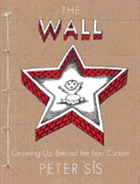
 "As long as he could remember, he had loved to draw" is how Sís's story begins. What follows, he says in an afterword, aims to explain to his children why he came to the U.S. from his native Czechoslovakia ("It was all because of drawing"). This tale of an artist's pursuit of the freedom to express himself provides the foundation for an unforgettable history lesson. And as with the best literature, the details of Sís's particular experience lead readers to discover universal truths.
"As long as he could remember, he had loved to draw" is how Sís's story begins. What follows, he says in an afterword, aims to explain to his children why he came to the U.S. from his native Czechoslovakia ("It was all because of drawing"). This tale of an artist's pursuit of the freedom to express himself provides the foundation for an unforgettable history lesson. And as with the best literature, the details of Sís's particular experience lead readers to discover universal truths.In his one-page introduction, Sís distills the cataclysmic events that shook Europe in the 20th century. Students of history would be hard pressed to find a clearer, more succinct summary of what led to the division of Europe and the raising of the Iron Curtain. The third-person narrative about the boy artist develops with a phrase or sentence at the foot of each page; above the text, larger developments unfold in pen-and-inks and captions. The narrative's simplicity is deceptive: "After drawing whatever he wanted to at home,/ he drew what he was told to at school." Panel illustrations show his parents' concern when he brings home from school drawings of tanks ("Russian-language classes--compulsory . . . . Political indoctrination--compulsory," read the captions). Except for the boy's drawings, the only color on these panel illustrations is the red of the scarves on the Young Pioneers and the hammer and sickle of the Russian Communist party. At a pivotal moment, when the hero has an epiphany, red spills over a full-bleed spread: "This was the time of brainwashing."
Next follows the first of three spreads of journal entries. Framed with drawings by and photos of the author-artist, these entries further personalize the global events (with a 1954 entry about his filmmaker father, for instance, Sís distills into two sentences the events of his extraordinary Tibet Through the Red Box). He characterizes the secret police as pigs and the Beatles as agents of change. Seemingly surreal images (e.g., a man with a swan on his head, a fish with a human face) suddenly come into sobering focus in later pages, as the grown hero dreams of escape--swimming a channel or riding his bike with his drawings transforming into wings to carry him away. In the hero's daydreams, the recurrent image of the Manhattan skyline and the Statue of Liberty holds a promise of freedom, rendered in the blue palette of a boundless sky. Although Sís's fans know how his story ends (he now lives in New York's Hudson Valley), this extraordinary achievement is a powerful reminder of the hard-won freedoms that drew so many to this country's shores.--Jennifer M. Brown

